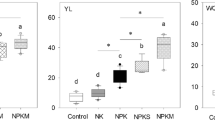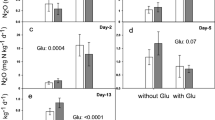Summary
A bioassay of microbially available soil N and P is described. It is based on the addition of glucose together with N or P to soil, followed by monitoring of the respiration rate. The addition of glucose + N resulted in an immediate increase in the soil respiration rate followed by a short period of exponential increase, reflecting the growth of microorganisms on the added substrate. The exponential phase levelled off, when lack of P prevented further growth of the soil microorganisms. The soil respiration rate then remained constant for several hours before decreasing, when glucose became limiting. The addition of glucose + P resulted in a lower plateau of the soil respiration rate, indicating that microbial growth was more limited by N than P in this forest soil (0.28 and 0.79 mg CO2 g-1 organic matter h-1, respectively). Additions of the limiting nutrient resulted in a proportional increase in the constant level of the soil respiration rate. This was used to calculated the increase in the soil respiration rate per mg N (0.71 mg CO2 h-1) or mg P (4.6 mg CO2 h-1) added to this particular soil. Microbially available N was then calculated in two ways from the regression equation (0.15 or 0.40 mg g-1 organic matter) and P (0.13 or 0.17 mg g-1 organic matter). A comparison with 2 M KCl extraction showed that in nutrient-poor forest soils the microbially available N was 6.3 or 18.5 times higher than the KCl extractable N.
Similar content being viewed by others
References
Anderson JPE, Domsch KH (1978) A physiological method for the quantitative measurement of microbial biomass in soils. Soil Biol Biochem 10:215–221
Binkley D, Hart SC (1989) The components of nitrogen availability assessments in forest soils. Adv Soil Sci 6:57–112
Binkley D, Vitousek P (1989) Soil nutrient availability. In: Pearcy R, Mooney H, Ehleringer J, Rundel P (eds) Physiological plant ecology: Field methods and instrumentation. Chapman and Hall, London, pp 75–96
Brookes PC, Powlson DS, Jenkinson DS (1984) Phosphorus in the soil microbial biomass. Soil Biol Biochem 16:169–176
Keeney DR, Nelson DW (1982) Nitrogen-inorganic forms. In: Page AL, Miller RH, Keeney DR (eds) Methods of soil analysis, part 2: Chemical and microbiological properties. Am Soc Agron, Madison, Wisconsin, pp 643–698
Marumoto T, Anderson JP, Domsch KH (1982) Decomposition of carbon-14 labeled and nitrogen-15 labeled microbial cells in soil. Soil Biol Biochem 14:461–468
Myrold DD, Tiedje JM (1986) Simultaneous estimation of several nitrogen cycle rates using nitrogen-15 theory and application. Soil Biol Biochem 18:559–568
Nannipieri P, Johnson RL, Paul EA (1978) Criteria for measurement of microbial growth and activity in soil. Soil Biol Biochem 10:223–230
Nordgren A (1988) Apparatus for the continuous long-term monitoring of soil respiration rate in large numbers of samples. Soil Biol Biochem 20:955–958
Nordgren A, Bååth E, Soderstrom B (1988) Evaluation of soil respiration characteristics to assess heavy metal effects on soil microorganisms using glutamic acid as a substrate. Soil Biol Biochem 20:949–954
Pirt SJ (1975) Principles of microbe and cell cultivation. Blackwell Scientific Publications, Oxford
Ruzicka J, Hansen EH (1981) Flow injection analysis. J Wiley & Sons, New York
Singh JS, Raghubanshi AS, Singh RS, Srivastava SC (1989) Microbial biomass acts as a source of plant nutrients in dry tropical forest and savanna. Nature (London) 338:499–500
Stanford G, Smith SJ (1972) Nitrogen mineralization potentials of soils. Soil Sci Soc Am Proc 36:465–472
Stotzky G, Norman AG (1961) Factors limiting microbial activities in soil: I. The level of substrate, nitrogen, and phosphorus. Arch Microbiol 40:341–369
Tamm CO (1991) Nitrogen in terrestrial ecosystems. Springer-Verlag, Berlin New York
Voroney RP, Paul EA (1984) Determination of biomass carbon and biomass nitrogen in-situ for calibration of the chloroform fumigation incubation method. Soil Biol Biochem 16:9–14
West AW, Ross DJ, Cowling JC (1986) Changes in microbial carbon, nitrogen, phosphorus and ATP contents, numbers and respiration on storage of soil. Soil Biol Biochem 18:141–148
Author information
Authors and Affiliations
Rights and permissions
About this article
Cite this article
Nordgren, A. A method for determining microbially available N and P in an organic soil. Biol Fertil Soils 13, 195–199 (1992). https://doi.org/10.1007/BF00340575
Received:
Issue Date:
DOI: https://doi.org/10.1007/BF00340575




